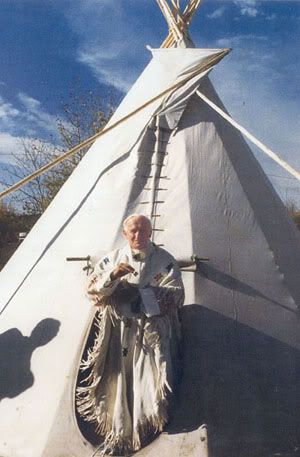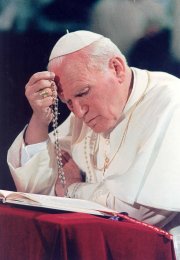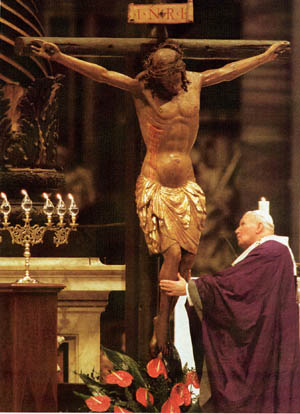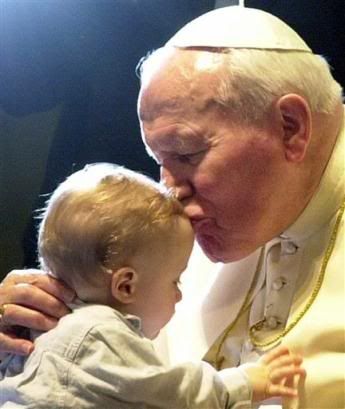"Rogito": the Document Placed in Pope's Coffin
OBITUS, DEPOSITO ET TUMULATO
IOANNIS PAULI PP II SANCTAE MEMORIAE
In the light of Christ risen from the dead, on April 2 of the year of the Lord 2005, at 9:37 p.m., as Saturday was coming to an end, and we had already entered the day of the Lord, octave of Easter and Sunday of Divine Mercy, the beloved pastor of the Church, John Paul II, passed from this world to the Father. The whole Church, in prayer, accompanied him in his passing.
John Paul II was the 264th Pope. His memory remains in the heart of the Church and of the whole of humanity.
Karol Wojtyla, elected Pope on Oct. 16, 1978, was born in Wadowice, a city 50 kilometers from Krakow, on May 18, 1920, and was baptized two days later in the parish Church of the priest Francis Zak.
He received his first Communion when he was 9 years old, and the sacrament of confirmation when he was 18. His studies interrupted, because the Nazi occupation forces had closed the university, he worked in a quarry and, later, in the Solvay chemical factory.
In 1942, aware of his call to the priesthood, he began courses of formation in the clandestine seminary of Krakow. He received his priestly ordination on Nov. 1, 1946, from the hands of Cardinal Adam Sapieha. Then he was sent to Rome where he obtained a licentiate and doctorate in theology, with a thesis entitled "Doctrina de fide apud Sanctum Ioannem a Cruce."
He returned to Poland where he had several pastoral duties and taught the sacred disciplines. On July 4, 1958, Pope Pius XII named him auxiliary bishop of Krakow. He was nominated archbishop of the same see by Paul VI in 1964. In this capacity, he took part in Vatican Council II. Paul VI created him cardinal on June 26, 1967.
He was elected Pope by the cardinals in the conclave on Oct. 16, 1978 and took the name John Paul II. On Oct. 22, the day of the Lord, he solemnly began his Petrine ministry.
John Paul II's pontificate was one of the longest in the history of the Church. In that period, under several aspects, many changes were witnessed. Counted among them was the fall of some regimes, to which he himself contributed. He undertook many trips to various nations for the purpose of proclaiming the Gospel.
John Paul II exercised the Petrine ministry with untiring missionary spirit, dedicating all his energies driven by "sollicitudo omnium ecclesiarum" and by open charity to the whole of humanity. More than any predecessor, he met with the people of God and leaders of nations, in celebrations, general and special audiences and pastoral visits.
His love of young people led him to initiate World Youth Day, convoking millions of youths in several parts of the world.
He successfully promoted dialogue with the Jews and with representatives of the other religions, convoking them at times to prayer meetings for peace, especially in Assisi.
He notably enlarged the College of Cardinals, creating 231 (plus one "in pectore"). He convoked some 15 assemblies of the Synod of Bishops, 7 ordinary general and 8 special. He erected numerous dioceses and circumscriptions, in particular in Eastern Europe.
He reformed the Western and Eastern Code of Canon Law, and created nine institutions and reorganized the Roman Curia.
As "sacerdos magnus" he exercised the liturgical ministry in the Diocese of Rome and in the whole world, in total fidelity to Vatican Council II. He promoted, in an exemplary way, the liturgical and spiritual life and contemplative prayer, especially Eucharistic adoration and the prayer of the Holy Rosary (Cf. apostolic letter "Rosarium Virginis Mariae").
The Church entered the third millennium under his leadership and celebrated the Great Jubilee of 2000, according to the guidelines indicated in the apostolic letter "Tertio Millennio Adveniente." She then faced the new age, receiving guidelines in the apostolic letter "Novo Millennio Ineunte," in which the faithful were shown the path of the future time.
With the Year of the Redemption, Marian Year and Year of the Eucharist, he promoted the spiritual renewal of the Church. He gave an extraordinary impulse to canonizations and beatifications, to show innumerable examples of holiness today, which would give an incentive to the men of our time. He proclaimed St. Therese of the Child Jesus Doctor of the Church.
John Paul II's doctrinal magisterium is very rich. Guardian of the deposit of faith, with wisdom and courage he did his utmost to promote Catholic, theological, moral and spiritual doctrine, and to oppose during the whole of his pontificate tendencies contrary to the genuine tradition of the Church.
Among his principal documents are numbered 14 encyclicals, 15 apostolic exhortations, 11 apostolic constitutions, 45 apostolic letters, in addition to the catecheses proposed in the general audiences and the talks given all over the world. With his teaching, John Paul II confirmed and enlightened the people of God on theological doctrine (especially in the first three important encyclicals -- "Redemptor Hominis," "Dives in Misericordia" and "Dominum et Vivificantem"), anthropology and social issues ("Laborem Exercens," "Sollicitudo Rei Socialis" and "Centesimus Annus"), morals ("Veritatis Splendor" and "Evangelium Vitae"), ecumenicism ("Ut Unum Sint"), missiology ("Redemptoris Mission") and Mariology ("Redemptoris Mater").
He promulgated the Catechism of the Catholic Church, in the light of tradition, authoritatively interpreted by Vatican Council II. He also published some volumes as a Ph.D.
His magisterium culminated, during the Year of the Eucharist, in the Encyclical "Ecclesia de Eucharistia" and in the Apostolic Letter "Mane Nobiscum Domine."
John Paul II left all an admirable testimony of piety, sanctity and universal paternity.
(Signatures of the witnesses of the burial ceremonies …)
CORPUS IOANNIS PAULI II P.M.
VIXIT ANNOS LXXXIV, MENSES X DIES XV
ECCLESIAE UNIVERSAE PRAEFUIT
ANNOS XXVI MENSES V DIES XVII
Semper in Christo vivas, Pater Sancte!

















 I think we all need a timeout from all the stress we've been feeling lately, and I just discovered a fabulous website featuring the artwork of Bl. Fra Angelico, my absolute favorite artist and a fine Dominican to boot.
I think we all need a timeout from all the stress we've been feeling lately, and I just discovered a fabulous website featuring the artwork of Bl. Fra Angelico, my absolute favorite artist and a fine Dominican to boot.






















































